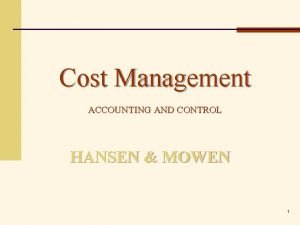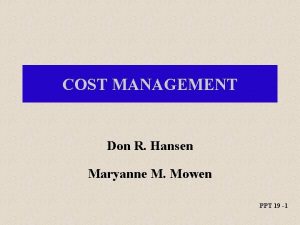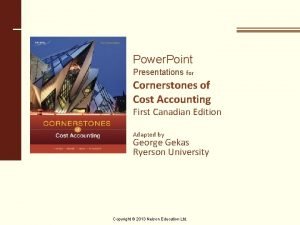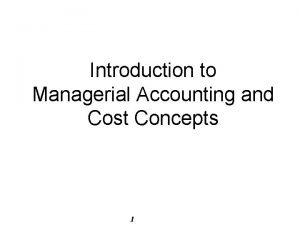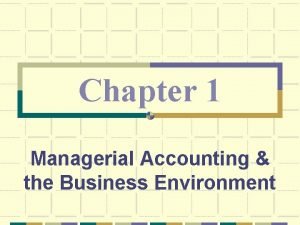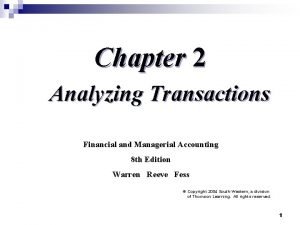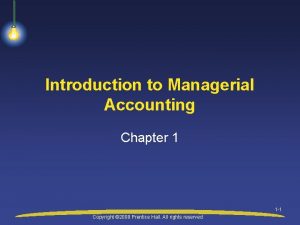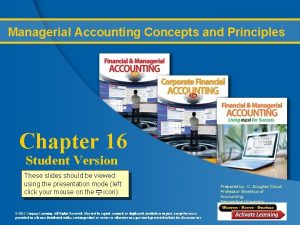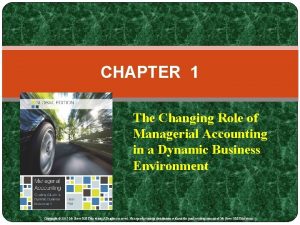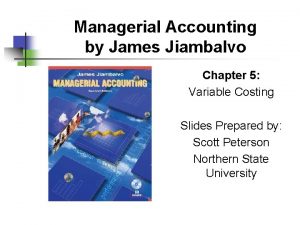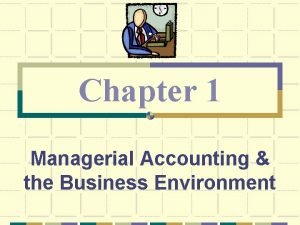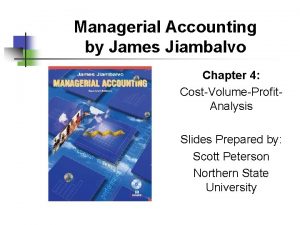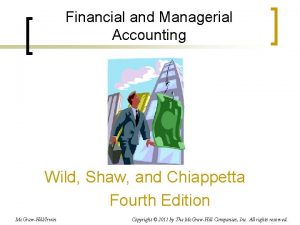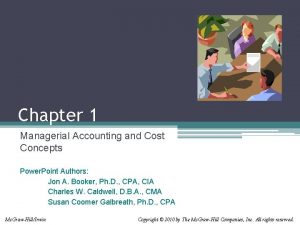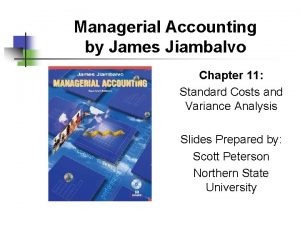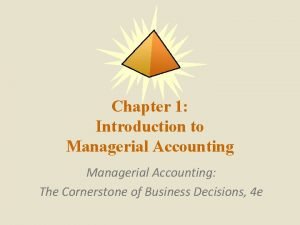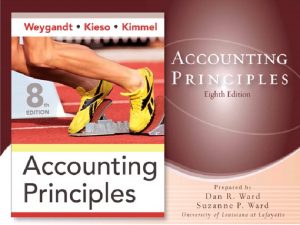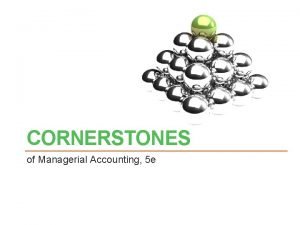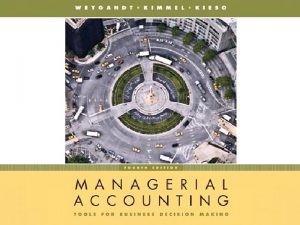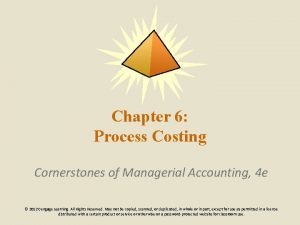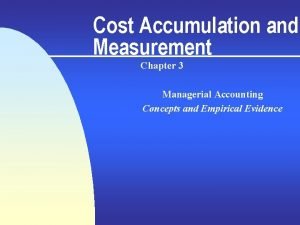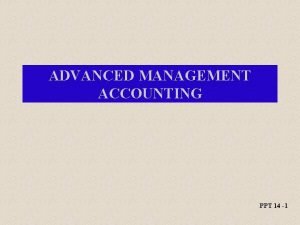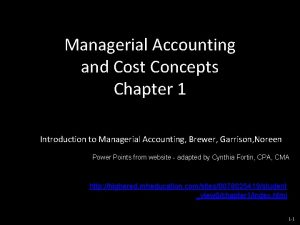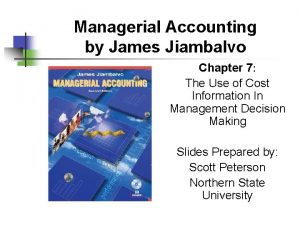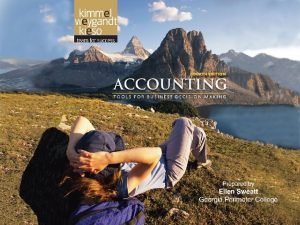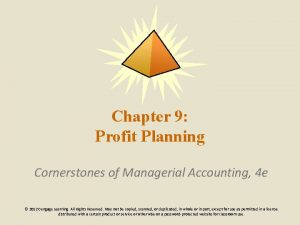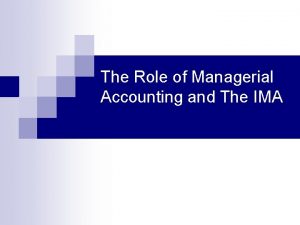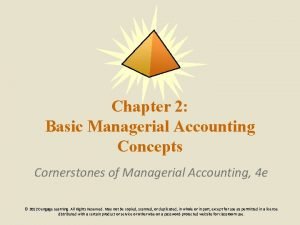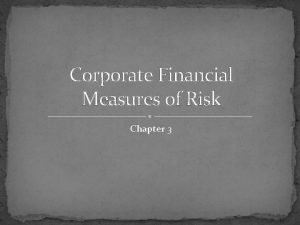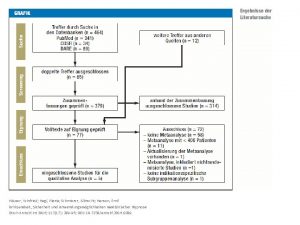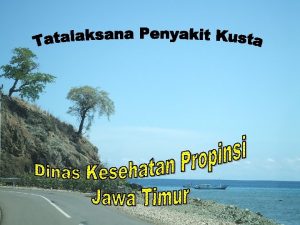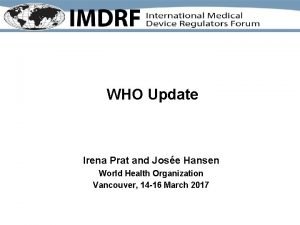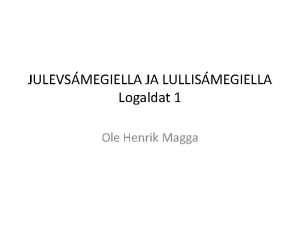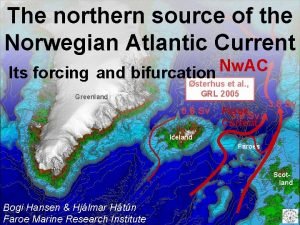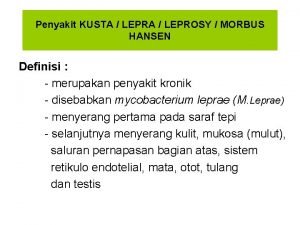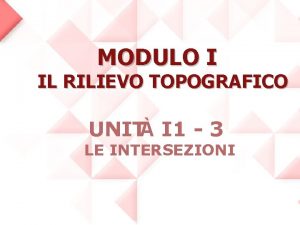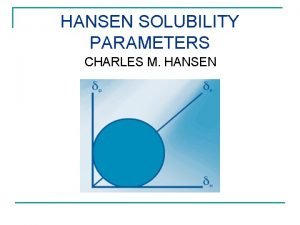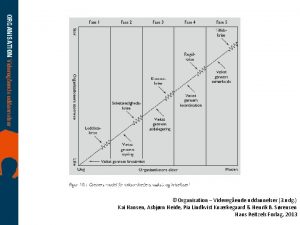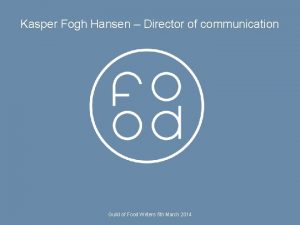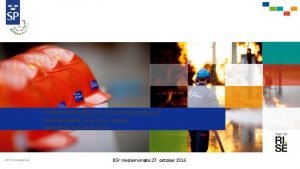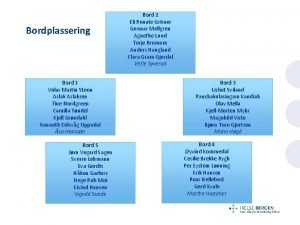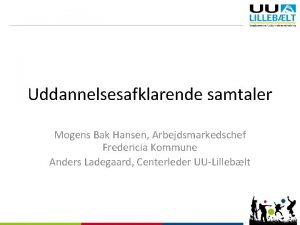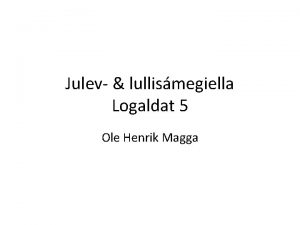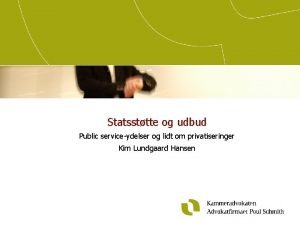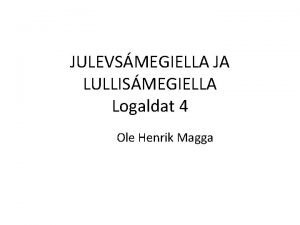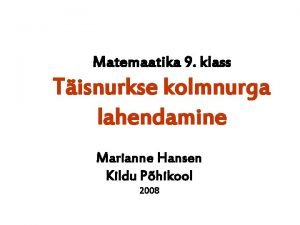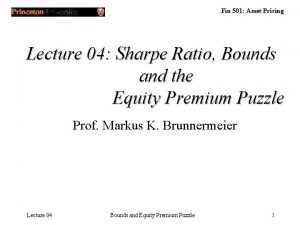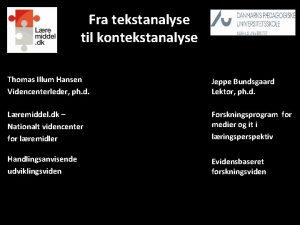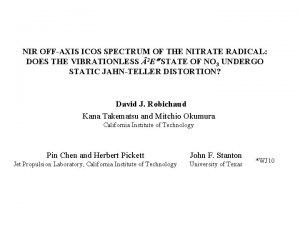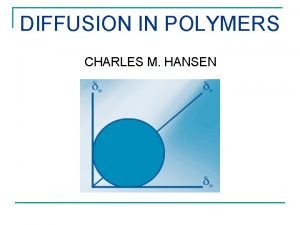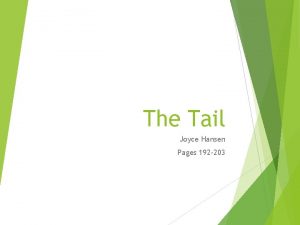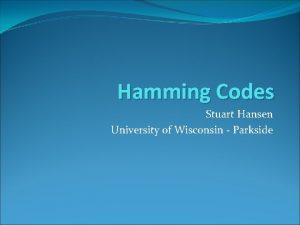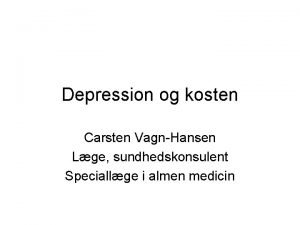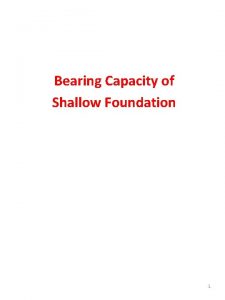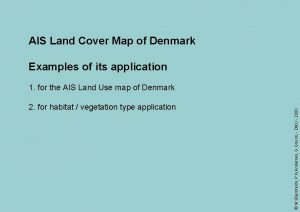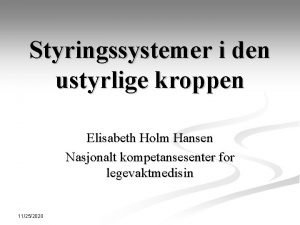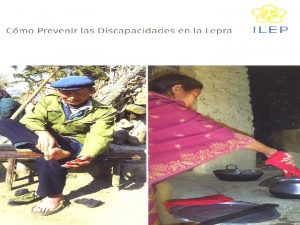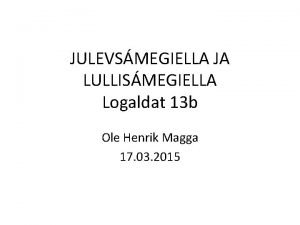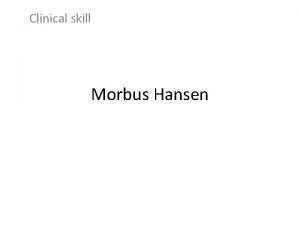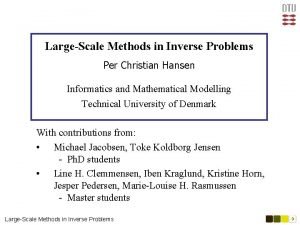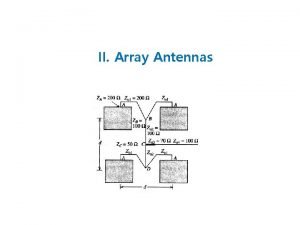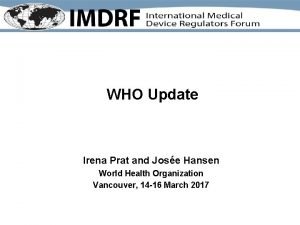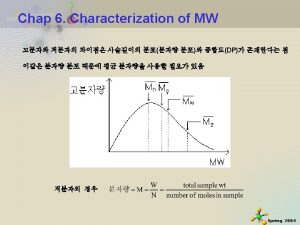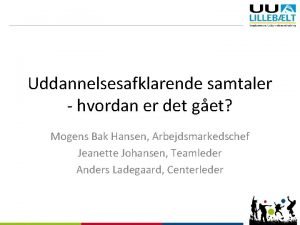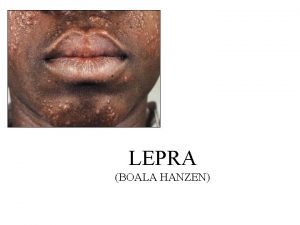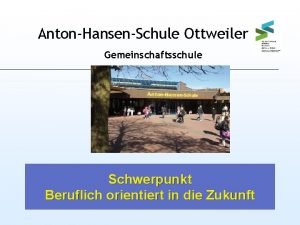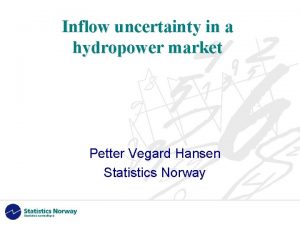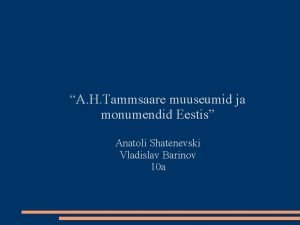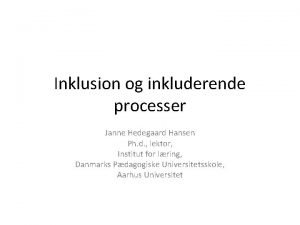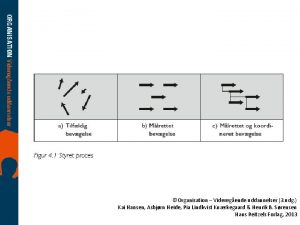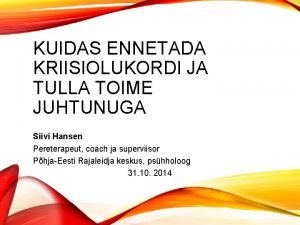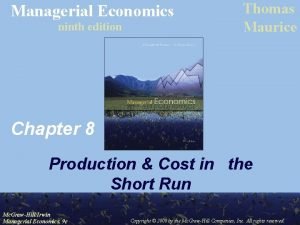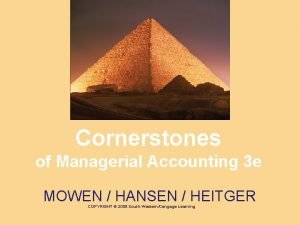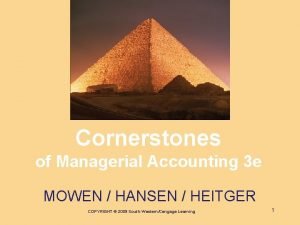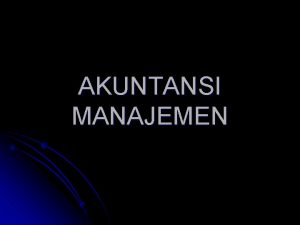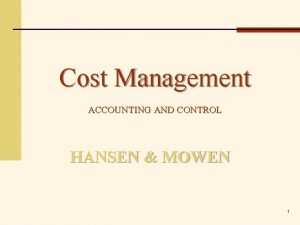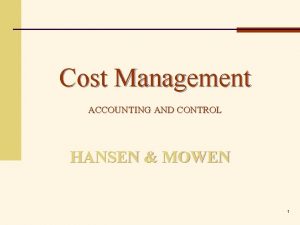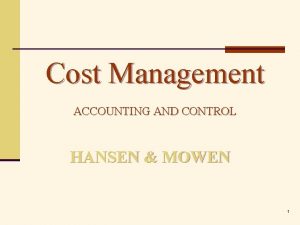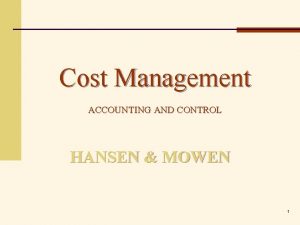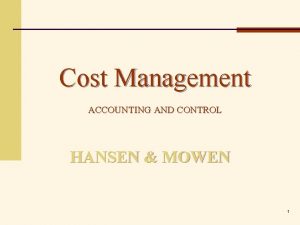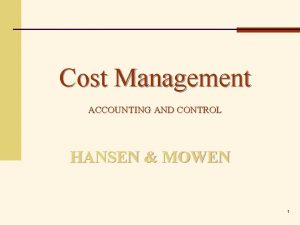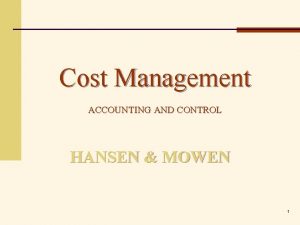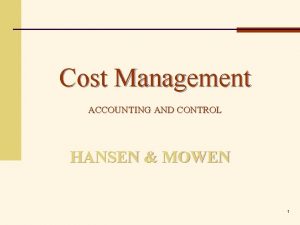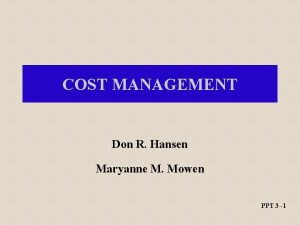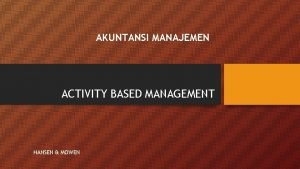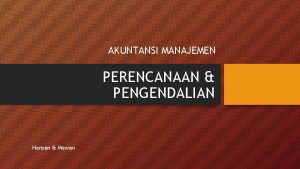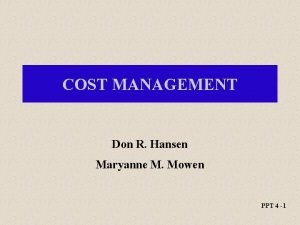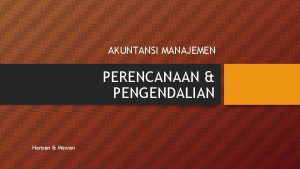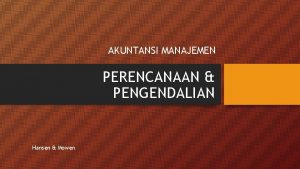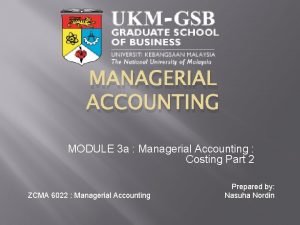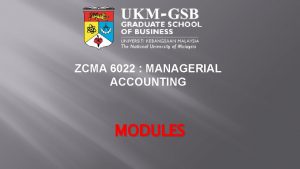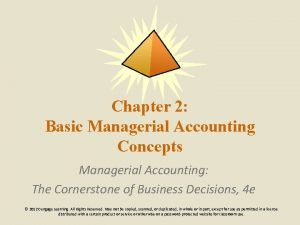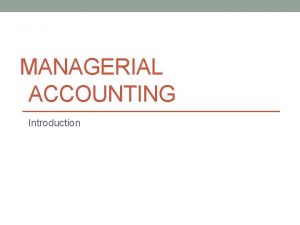Cornerstones of Managerial Accounting 3 e MOWEN HANSEN
































































































- Slides: 96

Cornerstones of Managerial Accounting 3 e MOWEN / HANSEN / HEITGER COPYRIGHT © 2009 South-Western/Cengage Learning

Chapter Six Process Costing

Learning Objectives 1. Describe the basic characteristics and cost flows associated with process manufacturing. 2. Define equivalent units and explain their role in process costing. Explain the differences between the weighted average method and the First-in, Firstout (FIFO) method of accounting for process costs. 3

Learning Objectives 3. Prepare a departmental production report using the weighted average method. 4. Explain how non-uniform inputs and multiple processing departments affect process costing. 4

OBJECTIVE 1 Describe the basic characteristics and cost flows associated with process manufacturing.

Characteristics of Process Manufacturing Process costing works well whenever relatively homogeneous products pass through a series of processes and they receive similar amount of manufacturing costs. Example Industries: Chemicals Tire manufacturers Food Large manufacturing plants

Types of Processes Sequential processing Requires that units pass through one process before they can be worked on in later processes. In each department materials, labor, and overhead may be added. After completing one process, the partially completed goods are transferred to the next department.

Types of Processes Parallel processing Partially completed units can be worked on simultaneously in different processes and then brought together in a final process for completion.

Raw Materials Cost Flow The manufacturing cost flows are generally the same as those for a joborder system. Raw Materials purchases As raw materials are purchased, the cost of these materials flow into a raw materials account.

Cost Flows Into Work In Process Work in Process + Materials + Direct Labor + Overhead Materials, labor and overhead flow into the Work-In-Process account.

Cost Flows Into Work In Process Work in Process + Materials + Direct Labor Finished Goods Completed Goods + Overhead Completed goods are transferred out of Work. In-Process and into Finished Goods

Cost Flows Into Work In Process Finished Goods + Completed Goods Cost of Goods Sold Goods + Sold Goods that are sold are transferred out of Finished Goods and into Cost of Goods Sold.

Cornerstone 6 -1 HOW TO Calculate Cost Flows Without Work-In-Process (WIP) 13

Example Information: Healthblend decides to produce 2, 000 bottles of multivitamins with the following costs: Picking Encapsulating Dept. Direct Materials $1, 700 Direct Labor Applied Overhead Bottling Dept. $1, 000 $800 50 60 300 450 500 600 14

Example Required: • Calculate the costs transferred out of each department. • Prepare journal entries that reflect these cost transfers. 15

Costs Transferred Out Picking Encapsulating Bottling Dept. Direct Materials $1, 700 $1, 000 $ 800 50 450 60 500 300 600 Costs added Costs transferred in $2, 200 $1, 560 $1, 700 0 2, 200 3760 Costs transferred out $2, 200 $3, 760 $5, 460 Direct Labor Applied Overhead 16

Journal Entries Work in Process (Encapsulating) Work in Process (Picking) $2, 200 Work in Process (Bottling) $3, 760 $2, 200 Work in Process (Encapsulating) Finished Goods Work in Process (Bottling) $3, 760 $5, 460

Transferred-In Costs are costs transferred from a prior process to a subsequent process. From the viewpoint of the subsequent process, transferred-in costs are a type of raw material cost.

Production Report Summarizes the manufacturing activity of a process department for a given period of time. Two sections: Unit Information section Cost Information section

Production Report Two sections: Unit Information section Units to Account For Cost Information section Units Accounted For Unit Information Section has two major subdivisions.

Production Report Two sections: Unit Information section Costs to Account For Cost Information section Costs Accounted For Cost Information Section has two major subdivisions.

Production Report Computing unit cost is a key part of the production report. Unit Cost is needed to: • Compute the cost of goods transferred out of a department • Value ending work-in-process inventory This is not easy. It is difficult to define the number of units produced.

OBJECTIVE 2 Define equivalent units and explain their role in process costing. Explain the differences between the weighted average method and the FIFO method of accounting for process costs.

Equivalent Units Example Assume that Department A had the following data for October: Units in beginning work in process Units completed Units in ending work in process (25% complete) Total manufacturing costs --1, 000 600 $11, 500 What is the output for this department? 1000 units? 1600 units?

Equivalent Units Example Assume that Department A had the following data for October: Units in beginning work in process Units completed Units in ending work in process (25% complete) Total manufacturing costs --1, 000 600 $11, 500 If we say 1000, we ignore the ending work in process.

Equivalent Units Example Assume that Department A had the following data for October: Units in beginning work in process Units completed Units in ending work in process (25% complete) Total manufacturing costs --1, 000 600 $11, 500 1600? Then we ignore the fact that the units in ending work in process are only partially completed.

Equivalent Units of Output • What are equivalent units? – The total number of complete units that could have been produced given the total manufacturing effort used during the period. • Dilemma – Some units are physically complete • Called Units Completed • When complete, units are transferred out – Some units are not complete • Remain in Work-In-Process • Degree of Completion must be determined

Cornerstone 6 -2 HOW TO Calculate Equivalent Units of Production: No Beginning Work-In-Process 28

Example Information: October Data: 1, 000 units 600 units Completed 25% Complete Required: Calculate the equivalent units for October. 29

Equivalent Units Completed Units in Ending WIP x 25% complete 1, 000 150 1, 150 30

Cornerstone 6 -3 HOW TO Measure Output and Assign Costs: No Beginning Work-In-Process 31

Example Information: Manufacturing Costs for the period Units Transferred Out Units in Ending Work In Process (25% Complete) 11, 500 1, 000 600 32

Example Required: • Calculate the unit cost • Calculate the cost of goods transferred out and the cost of ending work-in-process (EWIP)

Calculating Unit Cost per = equivalent unit Cost per equivalent unit Manufacturing costs Number of Equivalent Units $11, 500 = Cost per equivalent unit 1, 150 = $10

Cost of Goods Transferred Out Cost of goods transferred out Unit = Cost x $10 x Cost of goods transferred out = Units Transferred Out 1, 000 units $10, 000

Cost of Ending Work-In-Process (EWIP) Cost of ending work in process Unit = Cost x Units in EWIP $10 x 150 Cost of ending work in process = $1, 500 Things get more complicated if there are units in work-in-process at the beginning of the period.

Beginning Work In Process • Work done on these beginning inventory units – Represents prior period costs – How should these costs figure into the computation of current period unit costs? • Two methods – Weighted Average method – FIFO method

Weighted Average Method • Combines – Beginning inventory costs – Current period costs • Calculates Unit Cost for the period – By averaging • Unit cost is used to compute costs for: – Goods transferred out – Goods remaining in work-in-process

FIFO Method Separates work and costs for the equivalent units in beginning inventory from work and costs of the equivalent units produced during the current period. Only current work and costs are used to calculate this period’s unit cost.

OBJECTIVE 3 Prepare a departmental production report using the weighted average method.

Preparing a Weighted Average Production Report Step #1 Physical Flow Analysis • Trace the physical units of production – Two amounts are computed • Units Started and Completed – (Units Completed minus Units in BWIP) • Units Started – (Add Units Started and Completed plus EWIP)

Preparing a Weighted Average Production Report Step #2 Calculation of Equivalent Units • Adding together – Units Completed – Units in Ending Work In Process x Fraction Complete • Beginning Inventory – Included in the units completed – Treats beginning inventory as if it was started and completed the current period

Preparing a Weighted Average Production Report Step #3 Computation of Unit Cost • Manufacturing Costs ÷ Equivalent Unit – Costs include: • Prior period costs associated with beginning workin-process • Current period manufacturing costs

Preparing a Weighted Average Production Report Step #4 Valuation of Inventories • Computing cost of goods transferred out – Multiplying • Unit cost (computed in step #3) • Units completed (computed in step #1) • Computing cost of ending work in process – Multiplying • Unit cost (computed in step #3) • Equivalent units (computed in step #2)

Preparing a Weighted Average Production Report Step #5 Cost Reconciliation • Checks to see if – Costs to account for • Beginning Work In Process + Costs incurred during the period – Equal • Costs assigned to inventory – Transferred out + Ending Work-In-Process Cornerstones 6 -4, 6 -5 & 6 -6 will walk us through an example.

Cornerstone 6 -4 HOW TO Measure Output and Assign Costs: Weighted Average 46

Example Information: Production: Units in process, July 1, 75% complete Units completed and transferred out Units in process, July 31, 25% complete 20, 000 gallons 50, 000 gallons 10, 000 gallons

Example Information continued: Costs: Work in process, July 1 $3, 525 Costs added during July $10, 125

Example Required: • Calculate an output measure for July • Assign costs to units transferred out and ending work in process using the weighted average method

Measuring Output Add Units in Beginning WIP to the Units Started and Completed Started & Completed BWIP 20, 000 + 30, 000 50, 000 units completed this period

Measuring Output Add equivalent units in Ending WIP Units Completed 50, 000 + EWIP 10, 000 units (25% complete) 50, 000 + 2, 500 52, 500 equivalent units manufactured this period

Assigning Costs Compute Unit Cost Work in process, July 1 $ 3, 525 Costs added during July Total costs assigned 10, 125 $13, 650 Unit cost = $13, 650/52, 500 equivalent units Unit cost = $0. 26 per equivalent unit

Assigning Costs Assign Costs to Units Transferred Out (50, 000 units x $0. 26) $13, 000 Ending WIP (2, 500 equiv. units x $0. 26) 650 $13, 650 Total Costs Assigned All the manufacturing costs have been assigned.

Cornerstone 6 -5 HOW TO Prepare a Physical Flow Schedule 54

Example Information: Production: Units in process, July 1, 75% complete 20, 000 gallons Units completed and transferred out 50, 000 gallons Units in process, July 31, 25% complete 10, 000 gallons Required: Prepare a physical flow schedule

Physical Flow Schedule Units to account for: Units in beginning work in process (75% complete) 20, 000 Units started during the period This needs to be computed

Units Started and Completed Units started and completed Units – Units, BWIP = completed Units started and completed = 50, 000 – Units started and = completed 30, 000 20, 000

Units Started Units started = started and + Units, EWIP completed Units started = Units started 30, 000 = + 40, 000 10, 000

Physical Flow Schedule Units to account for: Units in beginning work in process (75% complete) Units started during the period Total units to account for 20, 000 40, 000 60, 000

Physical Flow Schedule continued Units accounted for: Units completed and transferred out: Started and completed 30, 000 From beginning work in process 20, 000 50, 000 Units in ending work in process 10, 000 (25% complete) Total units accounted for All the units “to be accounted for” have been “accounted for” 60, 000

Example Calculation of Equivalent Units completed 50, 000 This is the beginning work in process + the started and completed units.

Example Calculation of Equivalent Units completed Add: Units in ending work in process x fraction complete 50, 000 10, 000 x 25% 2, 500

Example Calculation of Equivalent Units completed Add: Units in ending work in process x fraction complete 50, 000 Equivalent units of output 52, 500 Now we need to calculate the unit cost

Example Computation of Unit Cost Work in process, July 1 $ 3, 525 Costs added during July Total manufacturing costs for July 10, 125 $13, 650 Unit cost = $13, 650/52, 500 Unit cost = $0. 26 per equivalent unit

Example Valuation of Inventories Cost of goods transferred to the encapsulating department $13, 000 50, 000 units x $0. 26

Example Valuation of Inventories Cost of goods transferred to the encapsulating department Cost of ending work in process $13, 000 650 2, 500 units x $0. 26

Example Cost Reconciliation Total manufacturing costs assigned to inventories are as follows: Goods transferred out Goods in ending work in process Total costs accounted for $13, 000 650 $13, 650

Example Cost Reconciliation Total manufacturing costs to account for: Beginning work in process $ 3, 525 Incurred during the period 10, 125 Total costs to account for $13, 650 It reconciles!! Costs assigned = Costs to account for

Cornerstone 6 -6 HOW TO Prepare a Production Report: Weighted Average Method

Example Information: Calculations in Cornerstones 6 -4 & 6 -5 Required: Prepare a production report

Healthblend Company Picking Department Production Report for July 2008 Unit Information Physical Flow Units To Account For: Units in Beg. WIP Units started Total units to account for Equivalent Units completed Units in EWIP Total equivalent units 20, 000 40, 000 60, 000 50, 000 2, 500 52, 500 Units Accounted For: Units completed 50, 000 Units in End. WIP 10, 000 Total units accounted for 60, 000

Healthblend Company Picking Department Production Report for July 2008 (Continued) Cost Information Costs to account for: Beginning Work In Process Incurred during the period $ 3, 525 10, 125 Total costs to account for $13, 650 Cost per equivalent unit $ 0. 26

Healthblend Company Picking Department Production Report for July 2008 (Continued) Transferred Out Costs accounted for: Goods transferred out $13, 000 Goods in Ending WIP --Total costs accounted for $13, 000 Ending WIP Total --$650 $13, 000 650 $13, 650

Evaluation of the Weigthed Average Method Major benefit of this method is the simplicity. Main disadvantage is reduced accuracy in computing unit costs. If greater accuracy is desired, a company should use the FIFO method to determine unit costs.

OBJECTIVE 4 Explain how nonuniform inputs and multiple processing departments affect process costing.

Nonuniform Application of Manufacturing Inputs • In the prior example – Materials, labor and overhead were applied uniformly throughout the process • But often materials is not added uniformly – Instead it is added at the beginning and ending of the process This leads to separate completion percentages for materials and conversion costs.

Nonuniform Application of Manufacturing Inputs Separate equivalent units, unit costs and category costs are computed for materials and conversion costs. Cornerstone 6 -7 will walk us through this.

Cornerstone 6 -7 HOW TO Calculate Equivalent Units, Unit Costs, and Value Inventories with Nonuniform Inputs

Example Information: Production: Units in process, Sept 1, 50% complete* 10, 000 Units completed and transferred out 60, 000 Units in process, Sept 30, 40% complete* 20, 000 * Percentage complete as to conversion costs

Example Information continued: Costs: Work in process, Sept 1: Materials* Conversion costs Total Current costs: Materials* Conversion costs Total $ 1, 600 200 $ 1, 800 $12, 000 3, 200 $15, 200 * Materials are added at the beginning of the process

Example Required: • Calculate equivalent units • Calculate unit cost • Calculate the valuation of the inventories

Example Calculation of Equivalent Units Materials Conversion Units completed 60, 000 Add: Units in ending work in process x fraction complete 20, 000 x 100% Since these units have all their materials

Example Calculation of Equivalent Units Materials Conversion Units completed 60, 000 Add: Units in ending work in process x fraction complete 20, 000 8, 000 20, 000 x 40% These units have 40% of their labor and overhead

Example Calculation of Equivalent Units Materials Conversion Units completed 60, 000 Add: Units in ending work in process x fraction complete Equivalent units of output 20, 000 80, 000 68, 000

Example Calculation of Unit Cost Unit materials cost = ($1, 600 + $12, 000)/80, 000 Unit materials cost = $0. 17 Unit conversion cost = ($200 + $3, 200)/68, 000 Unit conversion cost = $0. 05 Total unit cost = = Total unit cost $0. 17 + $0. 05 $0. 22

Example Valuation of Ending Work in Process and Goods Transferred Out Cost of ending work in process: Materials $0. 17 x 20, 000 $3, 400 Conversion $0. 05 x 8, 000 400 Total cost $3, 800 Valuation of goods transferred out: Cost of goods transferred out $13, 200 $0. 22 x 60, 000

Multiple Departments Some departments receive partially completed goods from prior departments. Usual approach is to treat transferred-in goods as a separate material category. Cost of this material is the cost of the goods transferred out as computed in the prior department.

Cornerstone 6 -8 HOW TO Calculate the Physical Flow Schedule, Equivalent Units, Unit Costs, and Transferred-In Goods

Example Information: • For September, Healthblend’s encapsulating department had: – 15, 000 units in beginning inventory • With transferred-in costs of $3, 000 – 70, 000 units completed during the month • Picking department – Completed and transferred-out • 60, 000 units at a cost of $13, 200

Example Required: • Prepare a physical flow schedule with transferred-in goods • Calculate equivalent units for the transferred-in category • Calculate unit cost for the transferred -in category

Example Physical Flow Schedule Units to account for: Units in beginning work in process 15, 000 Units transferred in during Sept. 60, 000 75, 000 Total units to account for

Example Physical Flow Schedule Units accounted for: Units completed and transferred out: Started and completed 55, 000 From beginning work in process 15, 000 Units in ending work in process 5, 000 Total units accounted for 75, 000

Example Equivalent Units for the transferred-in category Transferred-in: Units completed Add: Units in ending work in process x fraction complete 70, 000 5, 000 x 100% Since these units have all their materials

Example Equivalent Units for the transferred-in category Transferred-in: Units completed Add: Units in ending work in process x fraction complete Equivalent units of output 70, 000 5, 000 75, 000

Example Calculation of Unit Cost for the Transferred-in Category Unit cost For the transferred-in category

Example Calculation of Unit Cost for the Transferred-in Category Unit cost = ($13, 200 + $3, 000)/75, 000 Unit cost = $16, 200/75, 000 = $0. 216
 Strategic cost management hansen and mowen
Strategic cost management hansen and mowen Cost management hansen
Cost management hansen Cornerstones of cost accounting
Cornerstones of cost accounting 4 cornerstones of health
4 cornerstones of health Accounting scope
Accounting scope Definition of management accounting
Definition of management accounting Managerial accounting cost concepts
Managerial accounting cost concepts Managerial accounting and the business environment
Managerial accounting and the business environment Financial accounting chapter 2 solutions
Financial accounting chapter 2 solutions Managerial accounting skills are ______.
Managerial accounting skills are ______. Managerial accounting concepts and principles
Managerial accounting concepts and principles How managerial accounting adds value to the organization
How managerial accounting adds value to the organization Methods of cost estimation in managerial economics
Methods of cost estimation in managerial economics Managerial accounting chapter 5
Managerial accounting chapter 5 Accounting and the business environment
Accounting and the business environment Jiambalvo managerial accounting
Jiambalvo managerial accounting Wild financial and managerial accounting
Wild financial and managerial accounting Chapter 1 managerial accounting and cost concepts
Chapter 1 managerial accounting and cost concepts Managerial accounting james jiambalvo
Managerial accounting james jiambalvo Managerial accounting chapter 1
Managerial accounting chapter 1 Manufacturing accounting basics
Manufacturing accounting basics Managerial accounting chapter 13 solutions
Managerial accounting chapter 13 solutions Chapter 1 managerial accounting
Chapter 1 managerial accounting Managerial accounting chapter 6
Managerial accounting chapter 6 Cost accumulation
Cost accumulation Activity based management ppt
Activity based management ppt Managerial accounting and cost concepts
Managerial accounting and cost concepts Managerial accounting jiambalvo
Managerial accounting jiambalvo Financial and managerial accounting weygandt kimmel kieso
Financial and managerial accounting weygandt kimmel kieso Distinguishing features of managerial accounting
Distinguishing features of managerial accounting Managerial accounting chapter 9
Managerial accounting chapter 9 What is cma
What is cma Basic management accounting concepts
Basic management accounting concepts Dol managerial accounting
Dol managerial accounting Dr winfried hansen
Dr winfried hansen Klasifikasi morbus hansen
Klasifikasi morbus hansen Maria jose hansen
Maria jose hansen Ole henrik magga
Ole henrik magga Heather hansen artist
Heather hansen artist Bogi hansen
Bogi hansen 5a morbus hansen
5a morbus hansen Michael r hansen
Michael r hansen Snellius topografia
Snellius topografia Pauliina hansen
Pauliina hansen Mark hansen ucla
Mark hansen ucla Charles hansen
Charles hansen Organisation videregående uddannelser
Organisation videregående uddannelser Kasper fogh hansen
Kasper fogh hansen Robert hansen spy
Robert hansen spy Hansen dataset
Hansen dataset Icd 10 morbus hansen
Icd 10 morbus hansen Anne steen
Anne steen Martin steen hansen
Martin steen hansen Mogens bak hansen
Mogens bak hansen Ole henrik magga
Ole henrik magga Beck hansen loser
Beck hansen loser Kim lundgaard hansen
Kim lundgaard hansen Ole henrik hansen
Ole henrik hansen Pythagorase teoreem
Pythagorase teoreem Classification de danis weber
Classification de danis weber Hansen jagannathan bound
Hansen jagannathan bound Inautentisk
Inautentisk Jaron hansen byu
Jaron hansen byu Andy harris into thin air
Andy harris into thin air Charles m. hansen
Charles m. hansen The tail by joyce hansen questions and answers
The tail by joyce hansen questions and answers Inelegancies
Inelegancies Carsten vagn hansen kolesterol
Carsten vagn hansen kolesterol Ultimate bearing capacity
Ultimate bearing capacity Dmu-2000
Dmu-2000 Elisabeth holm hansen
Elisabeth holm hansen Bogi hansen
Bogi hansen Beck hansen enfermedad
Beck hansen enfermedad Pelle guldborg hansen
Pelle guldborg hansen Ole henrik hansen
Ole henrik hansen Hansen disease
Hansen disease Dr ginger hansen
Dr ginger hansen Enl morbus hansen
Enl morbus hansen Problems
Problems Hansen woodyard end fire array
Hansen woodyard end fire array Hanne foss hansen
Hanne foss hansen Maria jose hansen
Maria jose hansen Hansen solubility sphere
Hansen solubility sphere Mogens bak hansen fredericia kommune
Mogens bak hansen fredericia kommune Bacilul hansen
Bacilul hansen Anton-hansen-schule ottweiler
Anton-hansen-schule ottweiler Jan petter hansen
Jan petter hansen Anton hansen tammsaare muuseum
Anton hansen tammsaare muuseum Janne hedegaard hansen inklusion
Janne hedegaard hansen inklusion Asbjørn hansen
Asbjørn hansen Siivi hansen
Siivi hansen Gwen hansen
Gwen hansen Types of responsibility accounting
Types of responsibility accounting Intermediate accounting chapter 1
Intermediate accounting chapter 1 Computerized accounting notes
Computerized accounting notes Materiality concept
Materiality concept Managerial economics
Managerial economics
